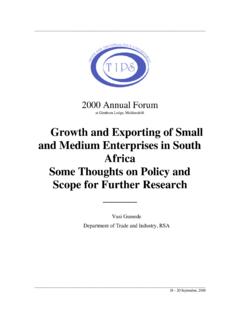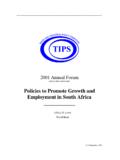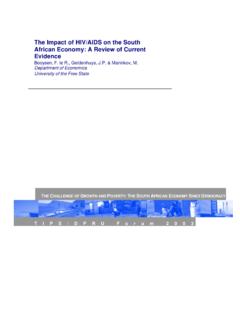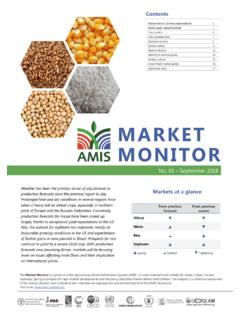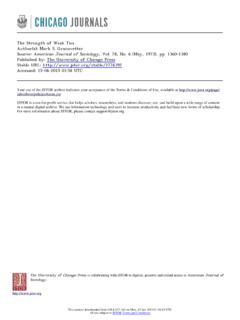Transcription of The Impact of HIV/AIDS on the South African Economy: A ...
1 The Impact of HIV/AIDS on the South African Economy: A Review of current Evidence Booysen, F. le R., Geldenhuys, & Marinkov, M. Department of Economics University of the Free State THE CHALLENGE OF GROWTH AND POVERTY: THE South African ECONOMY SINCE DEMOCRACY. T I P S / D P R U F o r u m 2 0 0 3. 2. The Impact of HIV/AIDS on the South African Economy: A Review of current Evidence1. Booysen, F. le R., Geldenhuys, & Marinkov, M. Department of Economics University of the Free State Bloemfontein, South Africa Paper prepared for TIPS/DPRU conference on The Challenge of Growth and Poverty: The South African economy since democracy'. 8-10 September 2003, Indaba Hotel, Johannesburg Abstract Even though the approaches, assumptions and results may vary greatly in the macroeconomic models employed in estimating the Impact of HIV/AIDS on the South African economy, the overriding message that these models convey remains the same: the cost of HIV/AIDS to South Africa will be significant in economic, social and human terms.
2 However, the accuracy of the models and their results can be faulted for various reasons, not least the shortcomings of current demographic projections and the empirical evidence on the microeconomic Impact of the epidemic, shortcomings that can be argued to translate into both under- and overestimation of the likely macroeconomic impacts of the epidemic. More work is also required to quantify the nature of the Impact of the epidemic on specific sectors in the economy. In addition, more recent, alternative methodological approaches can also be explored in further investigating the macroeconomic impacts of the epidemic. Finally, models are also constrained by a lack of clarity regarding the key question of how treatment, care and support for HIV/AIDS -affected individuals and households are to be financed in South Africa, given that government at times are unclear as to what policies will be implemented to fights HIV/AIDS .
3 South Africa currently faces one of the highest HIV prevalence rates in the world. The estimated adult prevalence of HIV amongst 15-49 year olds in 2001 was (UNAIDS, 2002), while the ASSA2000 model put adult prevalence amongst 20-65 year olds (in the unchanged scenario) at (ASSA, 2003). A recent national household survey in turn has put the 2002 estimate of adult 1. This research paper has been prepared with the aid of financial support from Trade and Industrial Policy Strategies (TIPS). 3. prevalence amongst those older than 25 years at (HSRC, 2002) 2. Given that HIV/AIDS . primarily effects the economically and sexually active population, the epidemic poses a serious threat to economic growth, development prospects and poverty alleviation. In fact, the predicted macroeconomic impacts of the HIV/AIDS epidemic make light of the macroeconomic targets of GEAR, given the projected decline in economic growth and employment.
4 The main aim of this paper is to review the current literature and evidence of the Impact of HIV/AIDS on the South African economy. The paper is structured as follows. Section 1 provides a brief overview of the methodology of the four macroeconomic models employed in estimating the impacts of the epidemic that are reviewed in this paper. (It should be emphasized however that this is not a methodological review of macroeconomic modeling, which is outside the scope of this paper.) Given that these models project the macroeconomic impacts of the HIV/AIDS epidemic over a 10-15 year period that ranges from 2000 to 2015 and that the HIV epidemic is yet to evolve into a full-scale AIDS epidemic, the emphasis in this paper is therefore on the future challenges that HIV/AIDS poses to the South African economy, rather than the challenges during the first 10 years of democracy3. Section 2 describes the main economic Impact channels of the HIV/AIDS epidemic as described in these four macroeconomic models, whilst section 3 and 4 respectively focus on an overview of the assumptions (input) and projected impacts on economic growth, investment, employment, and poverty (outputs) of these four models.
5 The assumptions and projections of these models are critically adjudged at the hand of currently available empirical evidence on the economics of HIV/AIDS in South Africa. In section 5, the implications to the macroeconomic modelling results of recent changes in the responses of government, business, communities and other role players in South Africa to the HIV/AIDS epidemic are discussed. Section 6 concludes, summarizing the main lessons to be learned from the review and the key questions that remain unanswered by current research on the economics of HIV/AIDS in South Africa. 1. Macroeconomic modelling of the Impact of HIV/AIDS . Initially, the primary focus in HIV/AIDS modelling was demographic, behavioural and epidemiological rather than economic in nature. However, some models have been developed and employed in estimating the resource requirements for financing prevention, care and treatment, and support interventions aimed at curbing the spread of the epidemic and mitigating its adverse 2.
6 The fact that these estimates are based on prevalence by different age categories precludes a direct comparison of these specific estimates of HIV prevalence. 3. However, it should be pointed out that Whiteside and Sunter (2000) argue that government's responses to the epidemic have lacked urgency and focus and that the situation could have been different had this not been the case (they point out that the HIV prevalence rate in 1994 stood at only, a figure that has since escalated to twice this figure). Section 6 of this paper again touches on these policy shifts with regard to HIV/AIDS over the past 10 years. 4. impacts on society, notably the Resource Needs Model (RNM), Goals Model (GM) and cost modules of the Spectrum model (Van der Heever, 2003). In more recent times, though, several models have been employed in directly modelling the future macroeconomic impacts of the HIV/AIDS epidemic on the South African economy.
7 Ford et al. (2002) distinguishes these models from so-called broad qualitative evaluations of the Impact of HIV/AIDS on macroeconomic variables and the case study approach, which entails the application of lessons from other country studies to say South Africa. According to Ford et al. (2002), current research on the macroeconomic Impact of the epidemic seek, in general, to quantify the effect of the epidemic as an endogenous shock on a volatile, emerging and globalised economic system'. Four such models are reviewed in this paper, , the Arndt and Lewis model (2000), the ING Barings model (2000), Burger's (2001) model, and the BER (2001) model4. These models each follow a different methodological approach to modelling the economic Impact of HIV/AIDS . The ING Barings (2000) and BER (2001) models follow a demand-side driven approach, while Burger (2001) follows a supply-side driven approach. Arndt and Lewis (2000) employ a supply-constrained Computable General Equilibrium (CGE) model in estimating the macroeconomic Impact of HIV/AIDS .
8 Macroeconomic models of the economic Impact of HIV/AIDS all require demographic inputs, actuary-based estimates of the Impact of the HIV/AIDS epidemic on the size and structure of the population. To date, most of these models have employed either the earlier Doyle-Metropolitan demographic projections or the later projections from the ASSA2000 model. Arndt and Lewis (2000) employ an economy-wide supply-constrained CGE model, the focus being South African economy's medium-term growth prospects . The ING Barings (2000) model employs the WEFA consultancy group's annual macro-econometric framework, which is based on the principle that in the short run, demand factors will dominate the economy, whereas in the long run, supply factors are more dominant. The ING Barings (2000) model therefore takes both the supply and the demand factors into account in the econometric modelling and, unlike the Arndt and Lewis (2000) model, the economic forecasts are mainly of a long-term nature.
9 4. This review excludes three other studies attempting to estimate the economic Impact of HIV/AIDS . Rather than estimate the various macroeconomic impacts of the HIV/AIDS epidemic, Broomberg et al. (1991). employed the human capital approach to estimate the Impact of HIV/AIDS in South Africa. The human capital approach entails the use of lost earnings as a proxy for total lost production attributable to HIV/AIDS . Haacker (2002) in turn discuss the macroeconomic Impact of the HIV/AIDS epidemic and applies a supply-side Cobb- Douglas approach in modelling the Impact of the HIV/AIDS epidemic. However, Haacker (2002) discusses this modelling approach in general and without any reference to or direct application to the South African economy. Finally, the recently published report on the estimated intergenerational Impact of HIV/AIDS on the South African economy (Bell et al., 2003), which although theoretically sound it may be said employs questionable assumptions in some instances with regard to demographic and economic responses to the epidemic, is not discussed here insofar as it employs a forecasting horizon (80 years) beyond those of the models discussed in this paper and does not report comparable forecasts for similar macroeconomic impacts of the epidemic to those discussed in this particular paper.
10 5. The BER (2001) model also makes use of econometric modelling techniques. BER (2001) stresses that their study should be seen as a macroeconomic sensitivity analysis rather than a forecasting model, with the baseline scenario reflecting the worst case demographic scenario that does not allow for behavioural changes or large-scale government intervention. Supply-side modelling is also a popular approach to determine the impacts of HIV/AIDS on the economy. This type of modelling is fairly simple and less sophisticated than other approaches. Burger (2001) extends the simple Cobb-Douglas production function to incorporate the key macroeconomic variables affected by HIV/AIDS . Being a supply-side oriented model, it relies solely on the factors of production and is used to calculate potential output, the level of aggregate output that can be sustained in the long run with stable inflation. The essence of this model is that the estimate of the long run growth rate of real GDP is represented as the sum of the growth rates of the labour force, capital and technology.


